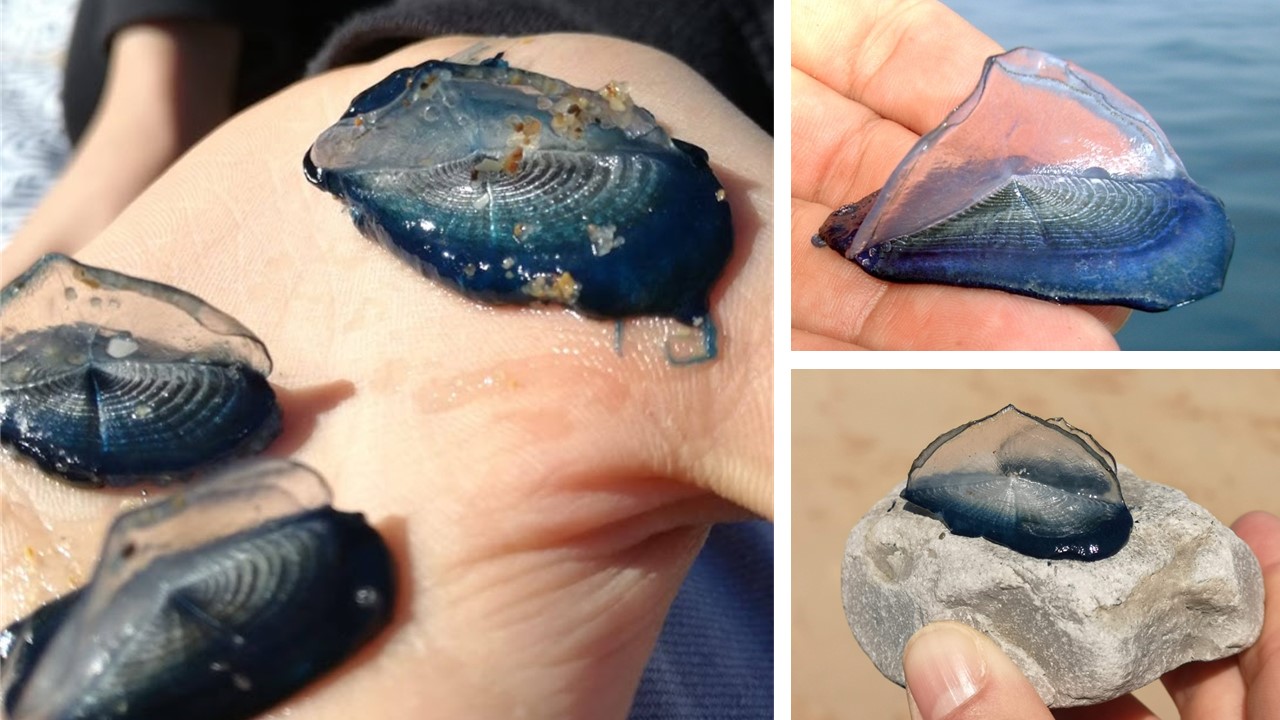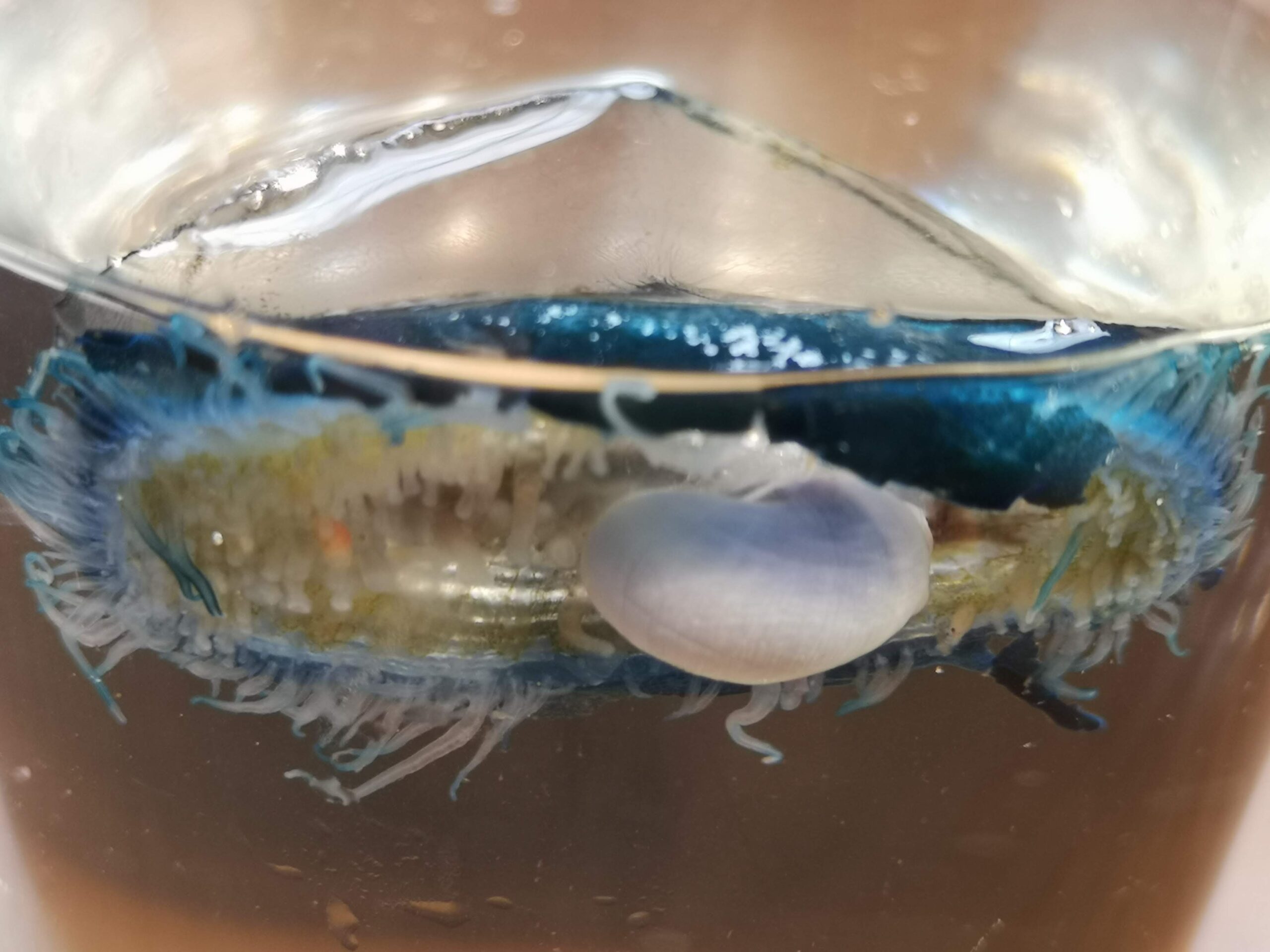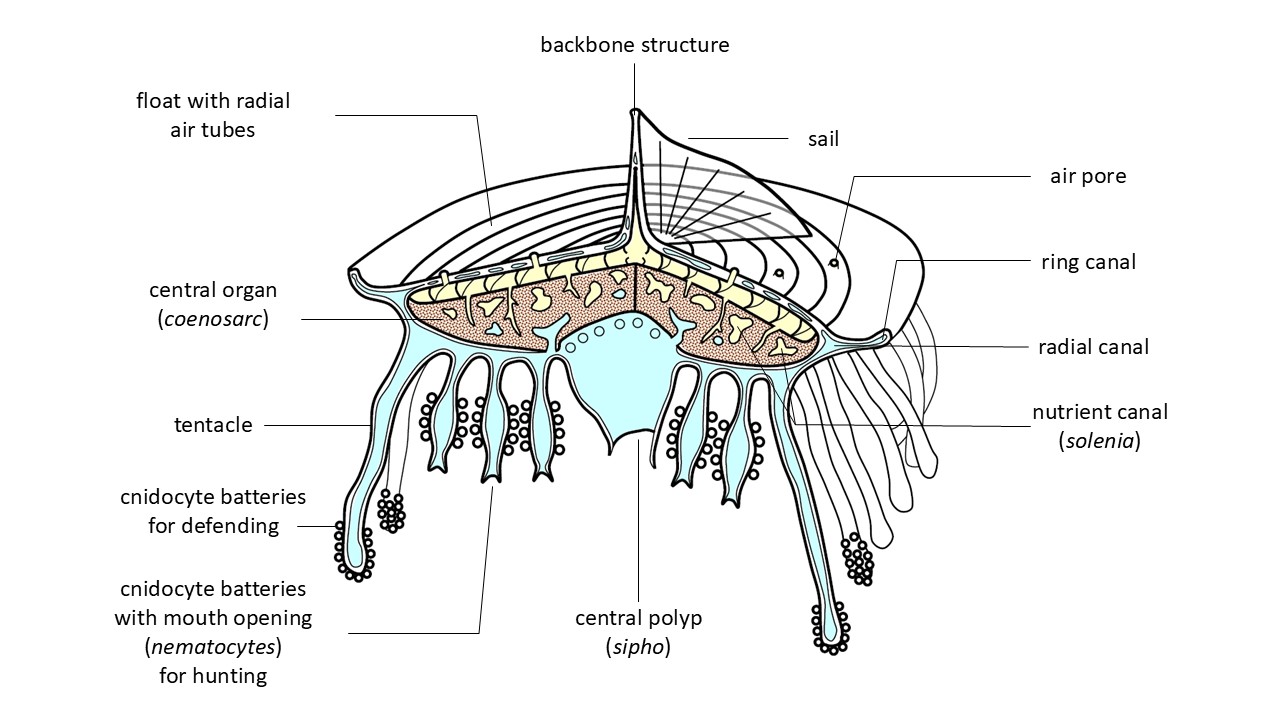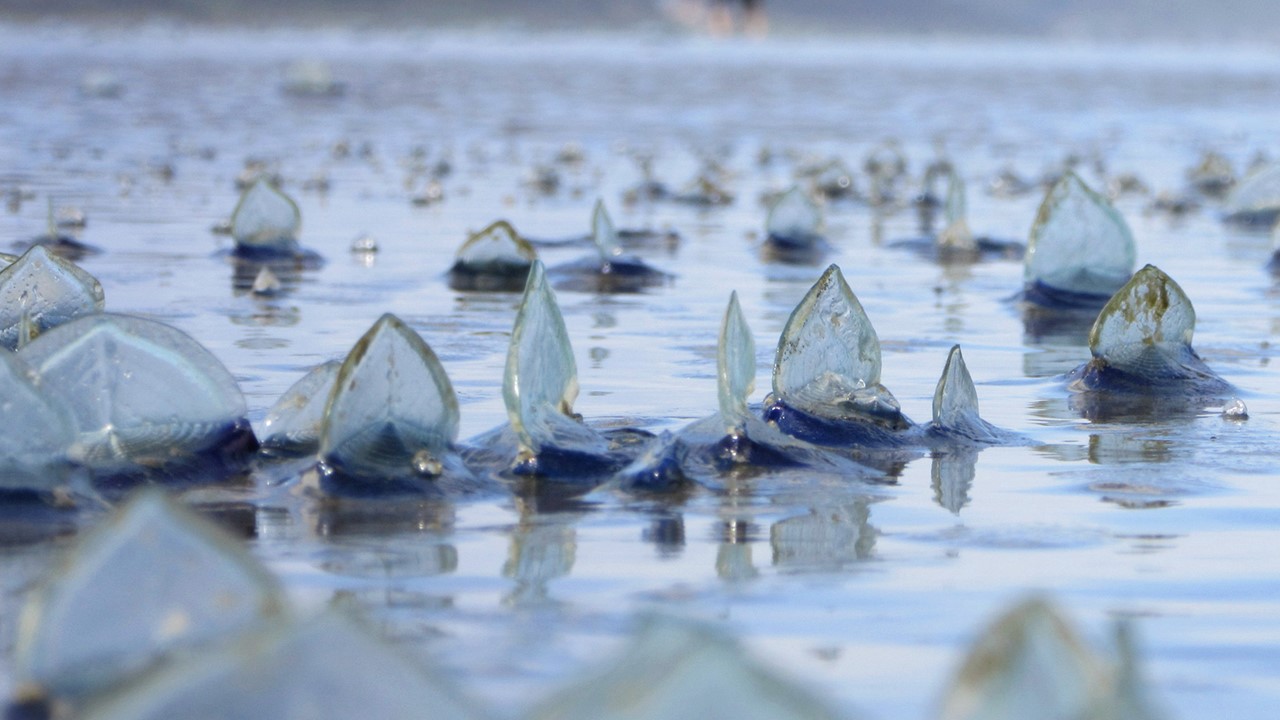Ribeira d’Ilhas, 2020 – At many sandy beaches, one stumbles upon a more or less wide ribbon of algae, seaweed, seagrass, wood pieces, pumice, shell fragments, fish spawn, remains of sea creatures and seabirds – and unfortunately, quite a lot of trash. This alluvial “scum” is a treasure trove for beachcombers. Especially after storms, one can discover all sorts of unusual things that the agitated sea has churned up from the deep and deposited onshore. Not long ago, for instance, the beach was littered with small, round bits of foil with a strange ridged surface – resembling the seals on barbecue sauce bottles. Sometimes these collections arise when a whole container load of floating items falls overboard, or when the flotsam is sorted hydrodynamically due to its drag resistance. That latter idea was a solid lead – but in this case, it turned out not to be plastic waste at all…

… but I only figured that out when I held not just a translucent “skeleton” but also a colorful little jellyfish of the same shape in my hand – which I then identified using Google Lens as Velella velella. I have to admit, this creature was completely unknown to me until then. But given the fact that both German and English have several common names for it – such as “by-the-wind sailor,” “St. Peter’s boat,” “purple sail,” “blue button,” or simply “sea raft” – one might assume it’s a run-of-the-mill species. Yet this little sailor jellyfish, whose Latin name Velella simply means “little sail,” is a truly remarkable organism. Like most jellyfish, it consists of a colony of specialized cells (polyps) with different tasks but no central control system.

It lives its life straddling ocean and atmosphere, feeding on tiny planktonic organisms that it “harpoons” with the stinging cells in its tentacles. The prey is drawn in through the mouths of the inner defense polyps or a large central feeding polyp (sipho) on the underside. Fortunately, the little stilettos it fires can’t penetrate human skin, so it’s safe to handle them. Most Velella drift in tropical waters, basking in full sunlight on the surface. To protect their DNA from UV radiation, their cell nuclei are surrounded by molecules of light-absorbing pigment, which also give them their beautiful deep blue color. The underside, by contrast, is very light, making them hard to spot from below against the sunlit surface.
Even more challenging than solar radiation are the shearing forces of wind and waves, which toss this delicate organism about. That’s why the air chambers of the round float, arranged in concentric, sealed-off rings, and the small triangular sail are reinforced with durable chitin tubes. The construction is so sophisticated that it has already inspired engineers.
As if life between the elements weren’t already tough enough, Velella also has a persistent enemy: the violet snail (Janthina janthina), a fellow sailing enthusiast. Its float and sail are made of sturdy bubbles it produces by trapping air in a thick body secretion. Hanging upside-down beneath this foamy raft, it drifts across the sea. Because it lives its life flipped over, its countershaded coloring is also reversed – white on top, blue on the bottom – with the same camouflage effect described earlier.
When it encounters a by-the-wind sailor, the snail lets go of its own raft and hitches a ride. Often, several violet snails will hang on as stowaways under the jellyfish, feeding on its tissues. As long as they keep their appetite in check and the jellyfish is lucky with its hunting, it can regenerate, and the drifting symbiosis stays balanced. But if the snails get too greedy and damage the float, buoyancy collapses. They all sink together and die, since the snails can’t make new bubbles without surface contact.

Although it was once given 32 different scientific names over time, researchers now agree that there is not only one species, but that Velella velella is the only known species in the entire genus Velella. This is quite rare in biology. So we are dealing with a true one-of-a-kind organism that ultimately had its earliest name, as coined by the venerable Linnaeus (1758), reinstated.

For various reasons, biologists have agreed not to treat jellyfish as individuals but rather as “task-sharing colonies” (like an ant colony). But when you look at what’s happening under the small sail, how all parts are connected by channels, and how specialized polyps function much like organs, you can’t help but question the definition. After all, Velella perform coordinated actions: twice a minute, the entire underside contracts, pressing air from the ring chambers out through pores, then relaxes again to draw in fresh air. Most creatures would simply call that “breathing” – though jellyfish don’t technically breathe. What does support the colony idea is the presence of “guest workers” onboard. In the upper region, dinoflagellates are housed – single-celled algae that thrive in bright light. When fishing is slow, these can be digested as backup food. In the reproductive cells below, bacteria live as symbionts, giving them a yellow-green tint. They’re passed on to the offspring as nutritional “starter kits.”
The reproduction of Velella is anything but romantic. Specialized reproductive polyps alternately bud off male and female “medusae.” Each contains half the genetic blueprint for a new colony. They must merge to create a fully formed larva. Before doing so, the medusae retreat to a depth of 1,000 meters, where the pitch-black cold offers better protection. Once they’ve digested their cargo of bacteria and algae, there’s little food left down there. But returning to the stormy surface is made possible by a fascinating mechanism: after the medusae fuse, the larva becomes buoyant thanks to a small oil droplet forming inside. This lightens it enough to float gently back to the surface and start a new colony. Under ideal conditions, Velella can reproduce explosively. In aquariums, the shed medusae appear as dense clouds that settle on the bottom and quickly cover it entirely. In the Atlantic, massive swarms stretching up to 260 kilometers have been recorded – sail by sail!

Mass strandings happen again and again, leaving shimmering blue carpets for kilometers along the coast, and sometimes even mounds up to two meters high made of millions of dead animals. When this phenomenon was studied more closely, researchers discovered that there are actually two distinct sail forms. They probably occur in a 50:50 ratio naturally, but any given stranding will only include one type. The mechanics of the sail determine how the organisms drift. Those with a sail shaped like a forward-slash (N) get pushed to the right by the wind, and those with the mirrored shape (Ͷ) to the left. This way, the entire population can never be stranded at once – some will always be blown away from shore. Brilliant, isn’t it? It reminds me of the wise lines by Ella Wheeler Wilcox:
Tis the set of the sails and not the gales, that tells it the way to go.
One ship drives east and another drives west, with the selfsame winds that blow.
Like the winds of the seas are the ways of fate, as we voyage along through the life.
Tis the set of a soul, that decides its goal, and not the calm or the strife.
Velella is born with a fixed sail orientation and then learns whether the storm wind will blow it to a deadly shore or back to safe sea. We, however, can choose how to set our sails – and whether to steer toward the heavens. A hopeful example from the Bible is young Daniel, who “resolved in his heart” to remain pure (Dan 1:8), navigating a straight course through one of history’s most turbulent centuries. Life’s circumstances cannot stop our journey – they only affect how long it takes to reach our destination. In that spirit: Bon voyage!
Proverbs 4:23: Guard your heart above all else, for it determines the course of your life
Sources:
Betti, F: Massive strandings of Velella velella (Hydrozoa: Anthoathecata: Porpitidae) in the Ligurian Sea. The European Zoological Journal 2019; 86(1):343-353
Bieri, R: A Morphometric Study of Velella (Hydrozoa) from different Oceans. Publications of the SETO Marine Biological Laboratory 1977; 24(1-3):59-62
Bieri, R: Dimorphism and Size Distribution in Velella and Physalia. Nature 1959; 184:1333-1334
Francis, L: Design of a Small Cantilevered Sheet: The Sail of Velella velella. Pacific Science 1985; 39(1):1-15
Francis, L: Sailing Downwind: Aerodynamic Performance of the Velella Sail. Journal of Experimental Biology 1991; 158:117-132 Schembri, PJ: When the Beaches Turn Blue. Gozo Observer 2016; 34:3-5


